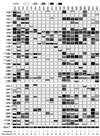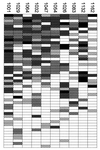Antibody recognition of Plasmodium falciparum erythrocyte surface antigens in Kenya: evidence for rare and prevalent variants
- PMID: 9916084
- PMCID: PMC96380
- DOI: 10.1128/IAI.67.2.733-739.1999
Antibody recognition of Plasmodium falciparum erythrocyte surface antigens in Kenya: evidence for rare and prevalent variants
Abstract
Plasmodium falciparum erythrocyte membrane protein 1 (PfEMP1) is the name given to a family of parasite proteins that are inserted into the infected erythrocyte surface. Studies using agglutination assays have shown previously that PfEMP1 epitopes are extremely diverse. In a study in Kenya, 21 parasite isolates, including nine from children with severe malaria, were tested for agglutination by 33 pairs of plasma, 21 of which were from the corresponding children. Each plasma pair consisted of a sample taken at the time of disease (acute) and one taken 3 weeks later (convalescent). In agreement with previous studies, infection was generally followed by the induction of antibodies specific to the homologous parasite isolate. In addition however, the results show that (i) some isolates were agglutinated very frequently by heterologous plasma; (ii) unexpectedly, these frequently agglutinated isolates tended to be from individuals with severe malaria; (iii) an inverse relationship existed between the agglutination frequency of each parasite isolate in heterologous plasma and the agglutinating antibody repertoire of the homologous child at the time of disease; and (iv) A 3-month-old child apparently still carrying maternal antibodies was infected by a rarely agglutinated isolate. This child's plasma agglutinated all isolates at the time of disease, apart from the homologous isolate. These results support the idea that preexisting anti-PfEMP1 antibodies can select the variants that are expressed during a new infection and may suggest the existence of a dominant subset of PfEMP1 variants.
Figures




References
-
- Aguiar J C, Albrecht G R, Cegielski P, Greenwood B M, Jensen J B, Lallinger G, Martinez A, McGregor I A, Minjas J N, Neequaye J, Patarroyo M E, Sherwood J A, Howard R J. Agglutination of Plasmodium falciparum-infected erythrocytes from east and west African isolates by human sera from distant geographical regions. Am J Trop Med Hyg. 1992;47:621–632. - PubMed
-
- Babiker H, Satti G, Walliker D. Genetic changes in the population of Plasmodium falciparum in a Sudanese village over a three-year period. Am J Trop Med Hyg. 1995;53:7–15. - PubMed
-
- Baruch D I, Pasloske B L, Singh H B, Bi X, Ma X C, Feldman M, Taraschi T F, Howard R J. Cloning the P. falciparum gene encoding PfEMP1, a malarial variant antigen and adherence receptor on the surface of parasitized human erythrocytes. Cell. 1995;82:77–87. - PubMed
-
- Berendt A R, Turner G D H, Newbold C I. Cerebral malaria: the sequestration hypothesis. Parasitol Today. 1994;10:412–414. - PubMed
Publication types
MeSH terms
Substances
Grants and funding
LinkOut - more resources
Full Text Sources
Other Literature Sources
Research Materials

